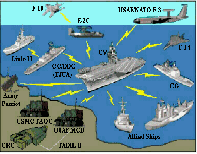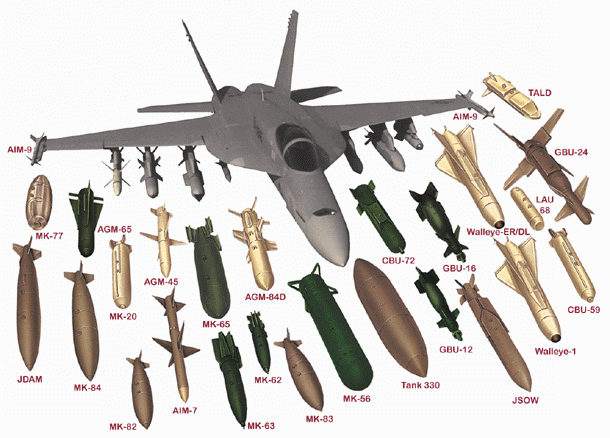It’ll be:
- away from home.
- against a sophisticated and well-armed enemy.
- depend as much on information technology as it will on bombs or missiles.
- a fight for which the service isn’t ready.
to territories (see Sun Tzu, "The Art of War"). To counter the A2/AD threats of the future, the Navy is developing a new way to fight in the air that will depend as much on communications networks as it will on advanced weaponry.
NIFC-CA
The heart of the new plan is a concept known as Naval Integrated Fire Control-Counter Air -- or NIFC-CA (pronounced: nif-kah). The central tenets behind NIFC-CA are situational awareness and
extended-range cooperative targeting. Every unit within the carrier strike group -- in the air, on the surface, or under water -- would be networked through a series of existing and planned datalinks so the carrier strike group commander has as clear a picture as possible of the battlespace. Players in NIFC-CA include:
 Aegis Missile Ships including DDG-51 Arleigh Burke class destroyers and CG-47 Ticonderoga class cruisers with SM-6 extended range standard missiles, combining the baseline standard missile with the capabilities of AMRAAM and Cooperative Engagement Capability (CEC) will be able to target enemy aircraft and missiles from beyond the range of the SPY-1 radar using data linked from the E-2D.
Aegis Missile Ships including DDG-51 Arleigh Burke class destroyers and CG-47 Ticonderoga class cruisers with SM-6 extended range standard missiles, combining the baseline standard missile with the capabilities of AMRAAM and Cooperative Engagement Capability (CEC) will be able to target enemy aircraft and missiles from beyond the range of the SPY-1 radar using data linked from the E-2D. UCLASS
E-2D Hawkeyes AEW Aircraft
 The next-generation, E-2D Advanced Hawkeye has a new radar, theatre
missile defence capabilities, multisensor integration and a Northrop
Grumman Navigation Systems tactical glass cockpit. Lockheed Martin
Maritime Systems & Sensors has developed the AN/APY-9 solid-state,
electronically steered UHF radar. The overall aerial battle manager for the air wing is expected to detect targets and guide weapons with its radar and electronic support measures and combine that information with data coming in from the EA-18G, F-35C and other sources. The primary data-link that enables these capabilities is the TTNT and Link-16/CMN.
The next-generation, E-2D Advanced Hawkeye has a new radar, theatre
missile defence capabilities, multisensor integration and a Northrop
Grumman Navigation Systems tactical glass cockpit. Lockheed Martin
Maritime Systems & Sensors has developed the AN/APY-9 solid-state,
electronically steered UHF radar. The overall aerial battle manager for the air wing is expected to detect targets and guide weapons with its radar and electronic support measures and combine that information with data coming in from the EA-18G, F-35C and other sources. The primary data-link that enables these capabilities is the TTNT and Link-16/CMN. 
EA-18G Growler EW Aircraft
The Growler will be used to provide jamming support for the F-35C and F/A-18s, especially to counter low frequency radars in an enemy air defense system. The Boeing EA-18G Growler is a cutting-edge electronic-warfare aircraft which is designed to perform escort and radar-jamming missions. EA-18G Growler block 1 is equipped with upto 3 AN/ALQ-99 radar jamming pods which houses exciters & high radiated power jamming transmitters. This will be replaces by the next generation Jammer being developed by Raytheon.
Using network coordinated tactics, the Growlers will also be used to find and eliminate electronic warfare assets. The Growler will use either the TTNT or Link-16/CMN-4 data link.
Avionics Magazine :: Raytheon’s Navy Contract Upheld, Jammer Development Resumes
The U.S. Navy has retained Raytheon as the prime contractor for
developing the $279.4 million Next Generation Jammer (NGJ) technology, a
replacement of Northrop Grumman's aging ALQ-99 tactical jamming system
on the Boeing EA-18G Growler. - See more at:
http://www.aviationtoday.com/av/topstories/Raytheons-Navy-Contract-Upheld-Jammer-Development-Resumes_81109.html#.UubZOrTTmJB
The Super Hornet will act as a truck carrying a heavy weapons load. For the strike role, it will carry long range precision guided missiles as far into hostile territory as it can go before releasing those weapons. The super hornet will not guide those weapons. They will be guided by data links from the E-2D and F-35. In the air defense role, the F/A-18's role will be similar - it will launcy missiles that might be guided by other aircraft like the E-2D.
F35C Joint Strike Fighter
The stealthy F-35C will act as the long range eyes of the fleet inside highly contested airspace using its combination of APG-81 radar, IR cameras, and ESM. It will relay targeting data back to the E-2D via a new low probability of intercept data link that will be integrated in the Block IV version.
Rise of the Data-Links
 The key challenges for NIFC-CA will be data-links. Every aircraft is
connected to every other aircraft in the carrier air wing via the E-2D,
which acts as a central node. The E-2D is also connected to the carrier
and the rest of the strike group -- making that aircraft a crucial asset
for future naval fires. Effectively, with NIFC-CA, the carrier strike
group would be able to cover hundreds of miles of territory with weapons
and sensors.
The key challenges for NIFC-CA will be data-links. Every aircraft is
connected to every other aircraft in the carrier air wing via the E-2D,
which acts as a central node. The E-2D is also connected to the carrier
and the rest of the strike group -- making that aircraft a crucial asset
for future naval fires. Effectively, with NIFC-CA, the carrier strike
group would be able to cover hundreds of miles of territory with weapons
and sensors.this fusion on there and fusion systems that would do their own track."
tactical targeting
network technology (TTNT)
"Now with the Rockwell Collins-designed tactical targeting network technology (TTNT) waveform, in our MIDS-JTRS [multifunctional information distribution system joint tactical radio system] radios, you're able to move that data back and forth," Manazir said. "Now I can bring that whole integrated architecture to the fight to deliver whatever effect I want to."
The TTNT waveform allows for very high data rates and has very low latency, making it ideal for sharing vast amounts of data over long distances, as was demonstrated during the Joint Expeditionary Force Experiment in 2008 at Nellis Air Force Base, Nevada. For the purposes of NIFC-CA, the TTNT would link together the carrier strike group's
- CVN
- E-2Ds,
- EA-18Gs,
- UCLASS.
Link-16/CMN-4
This version of Link 16 has 4x the throughput of basic link 16, and is a backup for TTNT. The Space and Naval Warfare Systems Command (SPAWAR), on behalf of the Multifunctional Information Distribution System (MIDS) Program Office (MPO, plans to award two sole source contracts to:- Data Link Solutions, L.L.C. and
- ViaSat Incorporated
CMN-4 consists of two capabilities, Concurrent Multi-Netting (CMN) and Concurrent Contention Reception (CCR). CMN is the ability of a Link 16 Terminal to receive multiple messages, each in different Link 16 nets, within the same Link 16 time slot. CCR is the ability of a Link 16 Terminal to receive multiple messages in the same Link 16 net within the same Link 16 time slots.
Northrop Grumman’s Multifunction Advanced Data Link (MADL),
New data link enables stealthy comms for F-35 | Air Force Times | airforcetimes.comF-35 has incorporated Northrop Grumman’s Multifunction Advanced Data Link (MADL), a system that’s undergoing testing in the California desert. MADL is a digital waveform that is designed for secure transmission of voice and data between F-35s, with the potential of linking F-35s to ground stations or other aircraft, Northrop said.
The communications, navigation and identification (CNI) system on an F-35 can manage 27 different waveforms, including MADL. The system will be included in the 2B software package that the Marine Corps’ F-35B jump-jet variant and the Air Force’s F-35A conventional take-off-and-landing version will use when they declare initial operating operational capability capacity (IOC) in 2015 and 2016, respectively. It also will be included in all international versions of the jet. The Navy’s F-35C carrier variant is expected to reach IOC in 2019 with the block 3F software, which will incorporate MADL and other capabilities.
What makes MADL more than just a communications tool is its ability to connect with other planes and automatically share situational awareness data between fighters. The more planes in the network the greater the data shared and the more comprehensive a picture is formed.







No comments:
Post a Comment